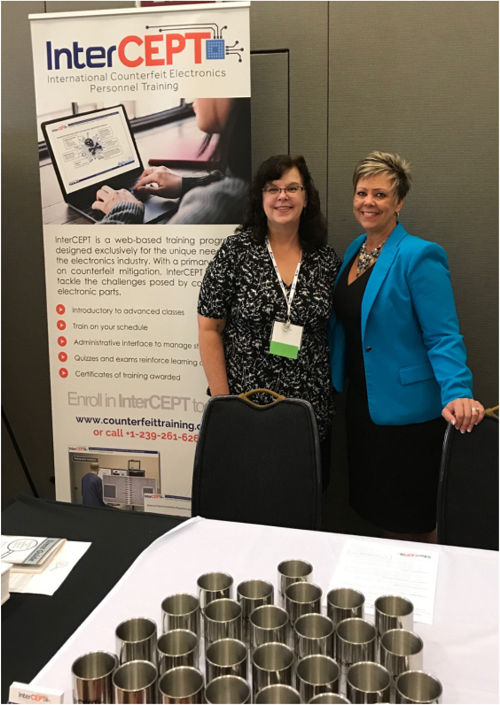Introducing InterCEPT: A Collaborative Training Program

By: Anne-Liese Heinichen
Over the last ten years, we have seen an emergence of new anti-counterfeiting standards at every level, as well as sweeping new government regulations, such as those of the US Department of Defense. Trained experts are needed to implement these standards, retain company certifications, plan for audits and ensure companies are employing best practices. Kristal Snider, Vice President of ERAI, Inc., and Anne Poncheri have collaborated to create
InterCEPT, a web-based training portal that provides a cost-efficient solution to train personnel about the challenges posed by counterfeit electronic parts.
InterCEPT's goal is to help individuals become one of those valued experts through a web-based training program designed exclusively for the unique needs of the electronics industry. With classes such as developing a documented counterfeit mitigation program, reporting and quarantining counterfeit and suspect counterfeit electronic parts and materiel, and inspection and testing of electronic parts,
InterCEPT's broad offerings are designed to augment the skills of professionals with roles in manufacturing, management, procurement, logistics, distribution, marketing, government agencies, law enforcement, legal services and consultancies.
I spoke to Anne and Kristal to find out their inspiration for
InterCEPT, how they envision the program working and what future plans are in store.
AH: How did the idea of
InterCEPT come about?
 Kristal Snider:
Kristal Snider: ERAI is regularly asked to provide training to individuals and organizations, both in- and outside of the high-tech electronics supply chain specific to counterfeit electronic parts. For years there has been a growing desire among professionals engaged in either buying, selling or using integrated circuits to learn everything they can to protect themselves, the companies they represent and their customers. While there are training opportunities for portions of the supply chain, when it comes to physically inspecting parts, there is nothing out there that addresses counterfeit avoidance using a holistic approach and the vast majority of the training opportunities that do come up require people to travel, making it more expensive and challenging for the individual and their employer. I understand the challenges people are facing, I saw the void and knew ERAI’s platform could provide the solution; I just needed the right partner.
Anne Poncheri: There is a very strong need across the supply chain for training on the subject of counterfeit electronic components. In the Defense Federal Acquisition Regulations, there is a requirement for training. Also, many government primes and OEMs have flow-down requirements for training about counterfeit electronic components. For larger companies, the resources may be available to develop in-house and web-based training. For smaller companies, their only option is publicly available training. Thus far, the only training that has been offered has been devoted to the specific set of requirements of an industry standard. Too often, these courses are focused only on the target audience of the standard.
Our goal in creating
InterCEPT was to develop training that would give all members of the supply chain a better understanding of the challenges of each tier in the supply chain. The various
InterCEPT classes will include a variety of topics, including a discussion on the difficulty in finding obsolete electronic components, how to test those components and how to report a counterfeit part to the industry. There will be a course to cover all aspects of mitigating counterfeit electronic parts in the supply chain.
AH: And what prompted you to develop InterCEPT now?
KS: It feels like we have been talking about counterfeit parts forever and yet we still regularly see escapes. How is that possible? The reality is there are huge gaps in counterfeit risk awareness levels based on where an organization is situated within the supply chain and their geographic location. When assessing training programs developed internally by organizations, we typically see a lack of consistency in the content of the trainings and more often than not, the trainings tend to be high level and general in nature. Evidence of counterfeit-specific employee training is now required in industry standards and government contracts and these training requirements are being flowed down. Existing personnel training programs are being scrutinized. Creating, maintaining and monitoring internal training programs is challenging and time-consuming. We knew organizations would be struggling to juggle another responsibility so we developed
InterCEPT to help meet personnel training obligations.
AP: The idea of developing training for counterfeit electronics has been in the back of my mind for about five years. In my various job functions in the past eight years, I've encountered many people who have very basic questions about why electronic parts are counterfeited, how they enter the supply chain and what is being done to keep them out of the supply chain. My goal with
InterCEPT is to be able to point prospective students to a link and allow them to choose the class that meets their requirements.
Although I have the skills needed to develop the training materials, I'm not capable of developing a web-site to deliver the training. The partnership with Kristal Snider to develop this product was perfect because we have complimentary skills and ERAI has the resources to develop first-rate course materials and website.
Each year, the topic of counterfeit electronic components continues to be a hot topic. There are continued efforts in the development of standards, the development of counterfeit detection test methods and the roll-out of government requirements. The topics are covered on several message board discussions, published articles and web-sites. However, there is not a central point to find the training needed.
AH: How do InterCEPT's classes differ from standard webinar-based trainings?
KS: InterCEPT differs in a variety of ways. Unlike a typical webinar,
InterCEPT courses undergo a peer review process to ensure the courses' content meets the needs of government, industry and the intended students. All courses are available on-demand and include resource materials or handouts. Students will be given quizzes throughout the course and must pass a final test in order to receive a training certificate. The courses were developed to ensure that the student listens to the content and understands the concepts.
AH: What is your vision for the supply chain and InterCEPT
AP: The vision for the student is to be able to customize their training needs by taking only the classes that they need. The classes are all between one and two hours long and they build upon each other. There are five different training tracks, but there are no required prerequisites. If one of our students is already familiar with the topic of electronic components, they can select the class that applies to their job function. However, if an employee has just been employed and needs to have a better understanding of counterfeit electronics, they can start at the beginning with the 'Counterfeit 101' class or the 'Supply Chain 101' class. These classes are intended to provide a starting point for the topic. The classes have been developed to build upon each other, using the same terminology to minimize the repetition of definitions and concepts.
The
InterCEPT product has also been developed with the Program Manager or Quality Manager in mind. These personnel are typically responsible for ensuring that the appropriate training is completed and the training records are available. With
InterCEPT's intuitive website, the manager may assign personnel to classes, give deadlines for the training and allow the
InterCEPT web-site to do the work for them. No more collecting and filing certificates of training. The certificates of training can be linked to a company account and the manager will have access to those training records with a few clicks on the website. There will not be any surprises during registration or customer audits. The report and the certificates can be generated and downloaded, if preferred.
AH: What are your future plans for InterCEPT?
AP: Now that the website is active, we are excited to begin a dialog with our customers. We have laid out the progression of course development, but we will modify our course development using feedback from our customers. In addition to the available courses, future courses are listed on the website. We are asking prospective students to click on a link to be notified when a specific course is complete. This feedback will help us to prioritize the class development.
KS: As Anne said, the immediate plan is to continue working on course development and peer review for the classes we have scheduled for release this fall. Feedback from the community is important to us. Please take a moment to let us know your thoughts. We'd love to hear what you think.
